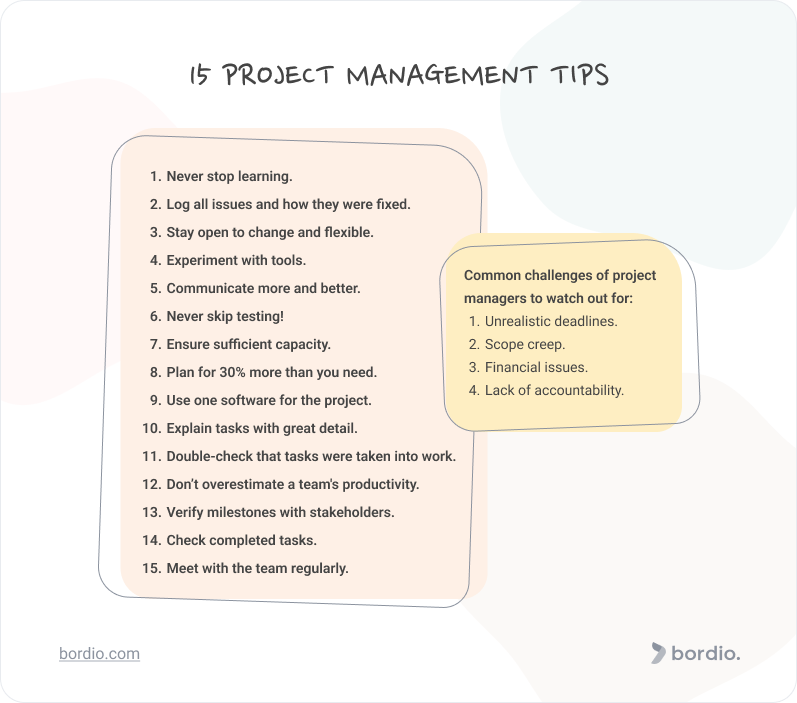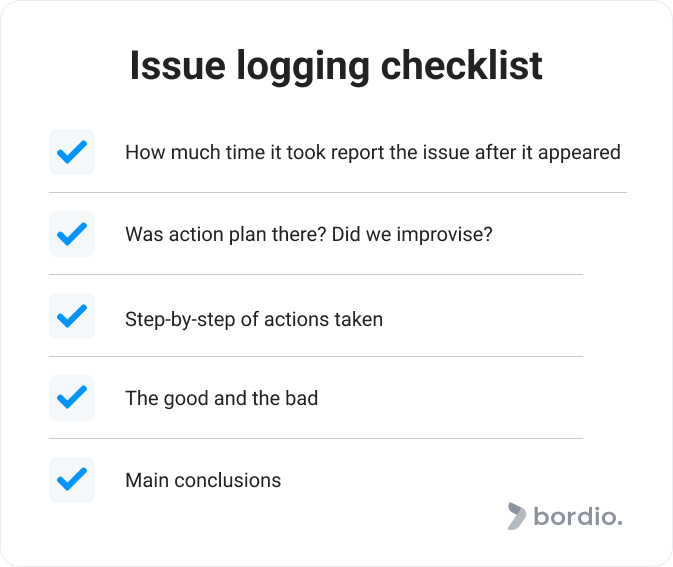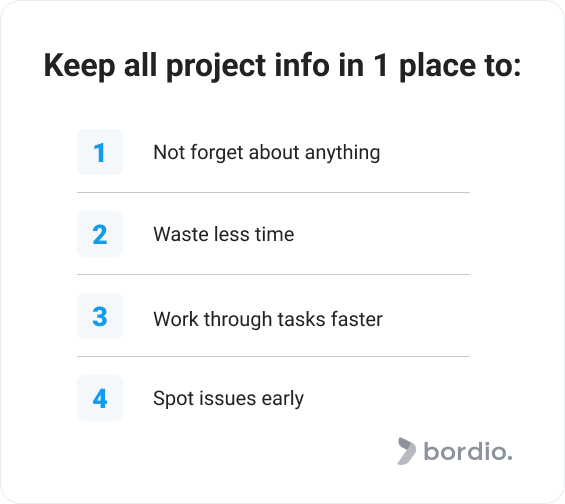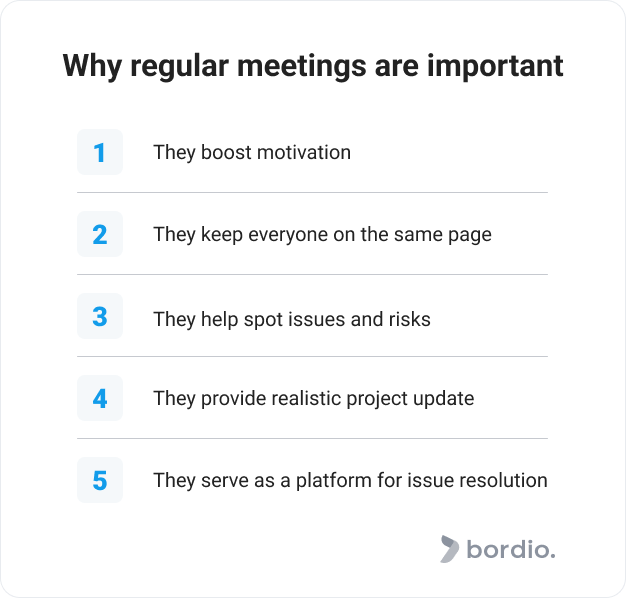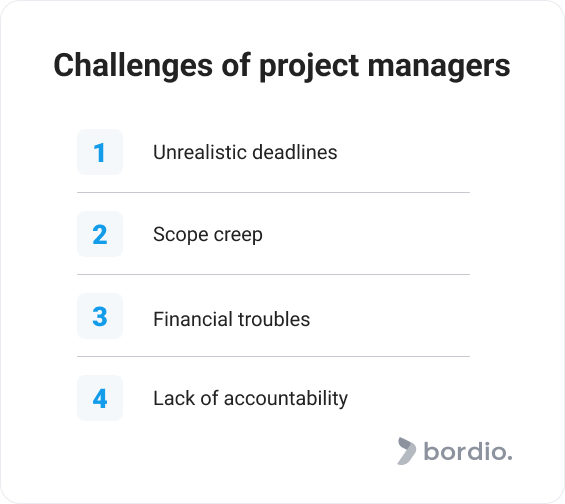Being a project manager is a fun ride. And what’s especially interesting about it, is that you won’t find 2 project managers who’ve had the same career path and experiences.
Working on projects, albeit all time planning involved in the process, involves a lot of uncertainty and chaos which can be intimidating. But fear not! We searched far and wide to locate the best project management tips that will elevate your day-to-day professional life as a perfect project manager.
Best project management tips for everyone out there
Project management is an art form, and a tricky one. To master it, one must possess many different skills and a wide knowledge of a variety of things. But there are also the little things that make the difference.
In today’s article, we have put together an extensive list of very different recommendations, each tried and tested by several generations of project managers. We hope you will take them to heart and implement them in your project management practice.
#1 Never stop learning – have a forever student mindset
In project management, success comes and goes in a blink of an eye. Circumstances change, new game rules come out, and external factors take a toll on our plans. The best tip that we can give to any project manager or, for that matter, any professional these days really is to keep learning and growing.
Whether it’s reading about project management skills and methodologies, taking on courses, implementing new software, or finding a mentor to guide you.
A good project manager is a jack of all trades, they are expected to know a bit about everything. And although it may sound daunting, you learn as you go. And with the right mindset focused on continuous improvement, anything that life throws at you becomes a valuable lesson and a learning curve.
#2 Log all issues and action plans to fix them
Many project managers talk about risk of task planning and issues management, but the actual process of dealing with the problem can be left unnoticed. Yet that’s where the unique knowledge lies that can help avoid the same threats in the future!
What you can log:
- How much time it took before the issue occurred was noticed and reported.
- Was there a plan in place already or did we have to come up with a solution?
- A step-by-step of what was done.
- Did something work exceptionally well or badly? Why?
- Main conclusions that the project manager and the team have drawn.
#3 Stay flexible and open to change
Guys, the words cannot describe just how important staying flexible and open to changes is in project management! It will save you a ton of headaches and, potentially, the project itself.
Imagine, you have a project in January 2020 where you are building a giant food market for people to dine and enjoy live music. Then the pandemic hits. And what happens if you’re against the change, and insist on continuing as you’ve planned initially? Nothing good! A flexible approach would be to pivot and start offering food deliveries with creative menus and Soundcloud playlists to align with the food and the mood. That way, you save the project, you provide a relevant product, and you can always resume the original plan once the pandemic is over!
It’s important to see the difference between good and bad change and to know when to give it a go and when to stop. But don’t be that guy who misses out on opportunities or ends up with a disaster because they were too stubborn to adjust their “perfectly fine” plan in your best schedule maker.
#4 Experiment with tools
Project management is constantly evolving, and there are so many existing and upcoming techniques and technology to make the process more enjoyable. Don’t get caught up with the old ways, especially if they involve manual labor.
Even today, with such a variety of modern solutions, many projects are still managed in Excel or worse – via email! Surely, that’s not a way to go.
Look for software to relieve you from tedious manual tasks. Solutions like Bordio’s online calendar planner can automate notifications, track overall workload, and more. There is really no need to waste time and invaluable resources on time-consuming low-value tasks when there are robust virtual planners that can do that.
#5 Remember to communicate, even when it seems unnecessary
Just like they teach us at the marriage counselor, communication is key to a healthy relationship. And it’s the same in project management!
Working with cross-functional teams, stakeholders, and suppliers naturally involves a ton of talking on the project manager’s end. But we don’t mean the bare minimum updates and email exchange. Really talk to stakeholders, hear out what they have to say, find out their motives and motivation, and learn to be a trustworthy partner.
Another way to build and maintain communication is through technology. Use automatic updates, and share the project timeline and progress. Tools like Scrum boards and general project dashboards will allow every stakeholder to check the latest data whenever they want.
Create a communication plan that will outline the frequency, topics, and channels of communication. It will cover all key things that must be talked about and support successful project outcomes.
#6 Never skip the testing phase
Don’t have time for testing? Absolutely sure that everything’s fine? Just did a minor change since the last milestone? We don’t care! Test everything and all the time.
The moment you stop tests thinking that it will be fine – you are in trouble and project milestones start to go downhill. Just like the doctor tells us, it is easier to prevent than to cure.
Test the functionality, test visuals, and get approvals from everyone for all project deliverables.
#7 Ensure sufficient capacity if working on multiple projects
For project managers and team members that work on several projects at once, make sure you confirm capacity with everyone before agreeing to take on a new project. When mentioning that it will be much easier to work in a team with team management software.
This tip would be more relevant to freelance project managers, or those who work for agencies where there’s not just one client, unlike if you work full-time for a vendor.
However exciting this new job might sound, it’s not worth overworking yourself up to a point of severe burnout. You won’t produce great project outcomes in the end either, so it’s a lose-lose situation really.
Just like all time management books teach us, there is time to grind and there is time to rest and recover.
Tip: Do an experiment and log all your tasks and meetings in the digital to-do list to track how much you are actually doing. We tend to underestimate how much time certain things take. After a few weeks you will know your real workload and will be able to make better decisions prioritizing your time and the time of your team. By the way, Bordio’s weekly planner allows you to see the automatically calculated workload for the day that includes tasks and events. Using best weekly schedule planner will help you not to overload your time.
We have already suggested using project management software to elevate the entire process. For example, in Bordio you can manage workload or capacity. The system shows you how much more bandwidth the project team has. And you also could try tools to manage remote employees.
#8 Plan 30% more time than you need
This tip is a lifesaver for new project managers but will be useful for experienced professionals as well.
If your project implementation plan says that you can do a project in 3 months, make it 4 months in the project scope. Trust us – you are more than likely to face some kind of unexpected circumstances that will delay the whole project delivery.
Somebody will get sick, or the supplier will delay the delivery. We’ve already seen a global pandemic and a number of international conflicts disrupt the entire world’s operations in the last couple of years. So yeah, something always comes up and the statistic tells us that most projects are delivered with delays. So if you plan for around 30% extra time, you have a solid chance of accomplishing what you promised.
#9 Use single software for all project-related activities
We’ve said it in our Time Management Tips article before and we’ll say it again – have a single solution for all tasks, plans, and to-dos in online weekly schedule maker .
The mistake many project managers often do is using different tools. Some tasks are logged in the task manager, other tasks are in Slack, plans are drafted in the smartphone notes, and something else is buried in emails. The result they get is an absolute mess.
When you log all tasks in a single daily planner, you make it very hard to forget something important.
#10 Explain tasks as detailed as possible
Often project managers assign tasks without supplying a detailed explanation. They leave it for the team members to figure out what exactly should be done, why is it necessary, and what the end result should look like.
More often than not, the assignee doesn’t understand the original idea and the dependencies. They end up completing the task differently from what the project manager had in mind and that creates tension.
How can the project manager fix that? One way is to attach screenshots when describing a task or even going as far as recording a short video instruction. It also helps to assume that you are dealing with a complete amateur. Things that we consider obvious are not always such for others. Don’t be condescending or patronizing, like if you are talking to a child, but learn to assume that the assignee knows very little about the task and requires extensive instructions.
Explaining what you need and having the end product match your expectations is one of the important leadership skills for anyone in a management position. After all, you can only blame yourself if you didn’t communicate the job correctly. And in the case of project management, the price for the mistake is way too high to risk it.
#11 Double-check that the tasks are taken into work
When a project manager assigns a task to somebody in their task management software, in addition to that they should send a quick message (for example, via a messenger or email) to the assignee and inform them about a new task.
Don’t assume that if you’ve sent something, it will be received and taken into work immediately. It might be ignored intentionally or not. And while yes, it is annoying, and it’s not your job to babysit anyone, it is your responsibility to deliver the project on time and within the project scope. So take that extra step and save yourself some trouble.
#12 Don’t overestimate the team’s capacity and productivity
It would be naive to assume that your project team members will do solid 8 hours of work on a given working day, yet many project managers fall into that trap.
People will have chit-chats and small talks whether by the water cooler or in Zoom. They will kill time checking emails, going to meetings, or dealing with some other problem that is not exactly a project task. In the most optimistic estimations, an average full-time employee manages a maximum of 6 working hours a day. And a more realistic estimation would be somewhere close to 5 hours a day.
So if you’ve struggled with proper project planning, not knowing what you’re missing and why there always seems to be a delay – perhaps that’s why.
By the way, we created a list of Best Productivity Books with many wonderful choices. Get some of them for your team to help them boost their focus and productivity.
#13 Verify milestones with key project stakeholders
An effective project manager informs key stakeholders about the project progress and gets approval for every feature or part that is being developed.
This verification process will look differently depending on the company’s policy and project management methodology that is being used. In Agile, for example, the role of project stakeholders is limited in the sense that the project team makes most key decisions after the scope is approved and the project beings.
However, don’t discount stakeholder management as something you shouldn’t worry about. First of all, you might bump into obstacles if someone doesn’t feel loved enough. Second, stakeholders are the ones who will approve the project when the time comes. Even if you are doing everything as pre-agreed before the project start, they still might not like the result. And the sooner you find out they’re unhappy, the less damage there will be to the project. It’s very hard to re-do things late in the game, even with techniques like fast-tracking that help speed the process up. So it’s better to avoid dissatisfaction altogether.
#14 Check completed tasks
As a project manager, you are responsible for the project success, and a smart and secure way to guarantee success is to check the completed tasks.
We don’t suggest you micro-manage every single little thing, especially if there are other managers in the project who report to you. Still, it makes sense to have a peek into completed tasks every once in a while. The frequency of such checks can depend on how long you’ve been working with the team member and how much trust and experience you share.
When you exercise this quality monitoring, make sure you do so in a respectful manner and not leave anyone thinking that they are incompetent. It makes sense to have a conversation with the team and explain your motivation to them.
Project managers are to an extent superheroes. They are expected to notice things that others miss. So it is only natural that they will be able to indicate if the task is not, in fact, fully completed. And once you’ve left your suggested improvements and they were implemented, it makes sense to have a final look at the work before signing it off.
Does this mean extra work for the project manager? Yes. But it contributes to better risk management and higher chances of the entire project success.
#15 Meet your team regularly
Every efficient project manager knows that managing projects without regular team meetings is a dangerous way to go.
Regular contact helps:
- Maintain and boost motivation.
- Make sure everyone’s on the same page.
- Spot any upcoming risks and threats.
- Get a realistic update on the project.
- Address concerns or issues that team members report.
Come together at least once a week, whether online or in real life. You will experience a much smoother project execution process if you do. Scrum has a great tradition where the team runs Daily Scrum meetings that take only 15 minutes and help get everyone together to boost morale.
Bonus tip: never miss a post-project evaluation session
In Agile and Scrum there is a tradition to have a retrospective meeting after the project (Sprint Retrospective in Scrum) where the team comes together to chat about the good, the bad, and the ugly.
The idea is that instead of blaming one another, we do an appreciation and critical thinking session, try to notice and remember what was good, and work out how to get rid of the bad parts and never repeat them again.
In Scrum, it’s usually done by the team and the product owner with a focus on the specific sprint. We suggest expanding that into stakeholders as well – see what they find great or irritating.
Stakeholders are important for the project’s success, maybe not so much as the team, but still. Their perspective can help make future projects and your approach to them that much more efficient.
Challenges that project managers face
We talked about the tips and tricks that support and enhance project managers’ work.
Now let’s talk a little about the common issues and challenges that PMs deal with, that our tips will help avoid or minimize.
Unrealistic deadlines
Unrealistic deadlines can be set for many reasons but the most common ones are:
- Lack of planning (no surprise there).
- The project management team is too excited to start already that it fails to acknowledge the true complexity of the endeavor.
- The fear of competition beating them with the earlier release.
How do you beat this challenge?
The best way to avoid incorrect deadlines is to take your time with planning. Dedicate time to creating a proper project roadmap and a risk management plan, create a work breakdown structure, and double-check everyone’s technical skills.
Then estimate the approximate timeframes and use our tip #8 by adding extra time to all scheduled tasks. So if you think a report requires 4 hours, plan for 6 hours instead. Also, find your critical path: identify dependencies, and see what can be done in parallel to save time.
Scope creep
Scope creep is a monster that comes when project goals and requirements deviate from the originally pre-agreed ones. Scope creep is one of the consequences of poor planning when the team doesn’t really understand the client and what they need, or because they didn’t check in with stakeholders enough and ended up building the solution nobody likes or wants.
How do you beat this challenge?
Do your research before the project begins. Run meetings with stakeholders and other team members to gather requirements and design a quality management process. Approve every goal/objective/expected deliverables of the project. Set up milestones with definitive acceptance criteria and deadlines. Prepare a detailed implementation plan to stay on track.
Financial issues
Insufficient cost management, coupled with poor planning and scope creep are synonyms of financial trouble. The issues often lie in focusing on the wrong goals and skills and ignoring the risks.
How do you beat this challenge?
Financial planning, budgeting, and staying within the budget are hard. Yet cost management is one of the essential project management skills that every project manager needs to master.
To do that, be ruthless during the planning stage. Ask for other stakeholders’ and team members’ involvement to plan the finances correctly. Ask suppliers to provide preliminary quotes during the budgeting phase and ask for better deals. Remember that nobody is born with strong negotiating skills but you can train them with time.
After the project has started, document the budget spending on time and review it regularly to spot bad tendencies.
Lack of accountability
The project’s success depends heavily on the team working on it. A project with the best planning and all the resources in the world will still have a high failure risk if there are internal issues with reliability and accountability.
How do you beat this challenge?
Build the right team who supports your views and values, and possesses similar work ethics. Easier said than done, huh?
Look for people with the right mindset. Sometimes having the right soft skills and less fitting hard skills is better than the opposite. Hiring someone is always a trade-off, so make sure you prioritize the rarest skills and characteristics when making the final decision. The rest can be taught. Use time manager system and plan your time properly and easily.
If you can’t build a team from scratch, try monitoring daily task progress. Daily standup meetings are great for that as they allow to softly track what’s up. Such a non-invasive format can help you identify key areas of improvement and discuss them one-on-one outside of the meeting.

